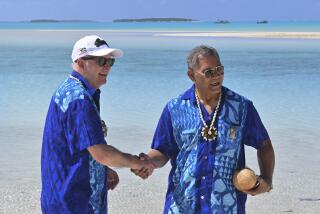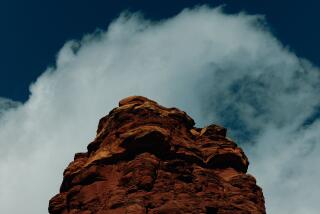Swept away by Down Under’s West coast
This is for those who don’t mind traveling to Earth’s edge to get somewhere extraordinary.
Broome is in the Kimberley, a hunk of Western Australia the size of California but whose population is only 41,000 hide-skinned, Akubra-sporting (you know, the iconic hat) individuals. It also has some of the country’s whitest sand, warmest waters, reddest cliffs and most outlandish geological formations.
And those hide-skinned people are almost bizarrely kind. Without fail, if you pull over to look at a map, take a photo or argue with your navigator, they stop their car to ask, “Youse alroight?” If you’re not alroight, they seem to find joy in dropping whatever they are doing to help.
Of course, the Kimberley also has man-eating saltwater crocodiles and an unsettlingly large number of the Earth’s most poisonous snakes, spiders and jellyfish. But in reality, a dangerous encounter is rare, unless you’re like the recent Aussie visitor to Broome who had one too many at the pub, broke into the wildlife park and tried to ride Fatso, a 16-foot, 1,700-pound saltwater croc. The local TV newscaster reporting the mauling could barely contain his mirth, asking, “Did Fatso get any fatter?” and blaming the man’s idiocy on the fact he was from “an Eastern city,” meaning Sydney or Melbourne. Western Australians like to distance themselves from the other coast.
The founding of Broome, the largest town in the Kimberley, reads like California’s Gold Rush but with mother of pearl instead of precious metal. Plastic eventually scuttled the mother of pearl industry so Broome learned how to farm pearls from the Japanese with their local, humongous pinctada oysters. Today the area produces some of the world’s largest and priciest pearls. Despite the riches, the town never lost its frontier spirit.
I’d been to Broome 15 years ago, fallen under the spell of its tropical climate, excellent food, gorgeous landscape and, above all, the town’s reverence for adventure. I had spent my time four-wheeling on crimson dirt roads to isolated beaches, visiting Aboriginal settlements, swimming in the warm sea, marveling at dinosaur footprints embedded in the ancient rocks and walking along Cable Beach, a 13-mile-long swath of white sand on which camels parade at sunset and shirtless men take their four-wheel vehicles with an “eskie” (cooler) of “stubbies” (beer) and a “stick” (fishing rod) after work.
I had sworn I would return.
In the interim, a handful of hotels, spas and wilderness retreats has opened. You can now have a world-class massage, then drive about 100 miles on an empty dirt road to Cape Leveque to swim on magazine-cover quality beaches “with no one within cooee,” as the Aussies say, referring to a shrill shout. You can then return to a chilled sweet, dry Sémillon and a meal of king prawns or pearl meat (tastes like abalone).
The Paspaleys, a multi-generation pearling family, have ventured into the hospitality business, opening the top two hotels in Broome, McAlpine House and Pinctada Cable Beach, and singlehandedly raising the town’s standards.
Pinctada Cable Beach Resort & Spa is the latest in their stable; it is a luxury property near Cable Beach. It is not right on the beach; Aboriginal land rights make it almost impossible to develop beachside. (The only hotel there today is the Cable Beach Club Resort & Spa, a large, family-style hotel built in the 1980s by Lord McAlpine, an eccentric Englishman who turned Broome from a “backabeyond” stop into a tourist-worthy town.)
Pinctada’s design is contemporary sophistication, built with a modern take on the traditional corrugated metal used to withstand torrential rain, harsh sun and tropical cyclones. Other than the large, swanky rooms, two restaurants, a hip bar and some exceptional Aboriginal paintings, the fabulous thing about Pinctada is the spa.
For 40,000 years Australian Aborigines used active plant ingredients and minerals for healing and health. Finally, someone has thought this wisdom worth reviving. The spa at Pinctada uses products developed with an Aboriginal elder. I had a memorable treatment with fragrant leaves and pods burning under the table, an exfoliation with finely ground pearl shell, a body mask of red mud topped with 700-million-year-old hot rocks and a massage with oils infused with bush botanicals.
You can’t go to Broome without doing two things: attending a movie at Sun Pictures, one of the world’s oldest outdoor movie theaters, and going into pearl shops to gape at $250,000 necklaces, confident in the knowledge that if you can afford them, they’re a steal.
Sun Pictures has been around since 1916. The canvas sling chairs are long-in-the-tooth and drastic on the behind, but you can buy a beer and settle in under a brilliant night sky. We saw “Bran Nue Dae”(Aborigine pidgin for “brand new day”), a feel-good musical-comedy movie, starring Geoffrey Rush and Ernie Dingo. It was filmed in Broome. Behind us sat two Aborigine teenagers who knew every line of the script and every song by heart.
A 75-minute drive south of Broome is Eco Beach Wilderness Retreat, a new resort on miles of deserted beach. The sand is powdery, the water aquamarine and the rocks luminous red. The arrival, however, is not easy. You drive on an interminable rutted road and enter from the back, then park and radio the hotel to come and get you. An hour later when you’re lunching on fresh-caught fish and sipping a frosty amber beverage beside the infinity pool, you understand that this is a sanctuary in the middle of gorgeous nowhere that would be heaving with tourists if it were any closer to a major city.
Eco Beach accommodates most budgets, from oceanfront bungalows to platform tents. It will cost you more to stay close to the beach, but it’s a long, hot trudge from the back of the resort.
Days at Eco Beach begin with a yoga class overlooking the cerulean sea and red rocks. Then the choices are to rest, eat, have a massage or go fishing, kayaking or stroll for as far as the eye can see along the beach.
One afternoon, we went stingray hunting with Neil McKenzie, an Aborigine from the local Yawuru people, considered the local custodians of the land. Just as in so many colonized countries, the Australian Aborigines had it rough when “whitefellas” arrived in 1788. Owning land was an anomaly to Aborigines, who considered themselves part of a larger scheme.
The settlers forcibly drove them off, often herding them onto missions where they were given Western names and forced to live as white men. Recently there has been a revival of the culture. Aborigine languages, which were banned from schools, are now taught again; healing traditions are venerated for their organic power, and the art has become stratospherically collectible, paintings selling in New York galleries for millions.
McKenzie got his name because his ancestors had little choice but to work for “whitefella” Jack McKenzie when he claimed ownership and founded a cattle station on the land where Eco Beach is. The land is now in the hands of the government, and Neil’s people were named custodians.
Aborigines have the right to hunt for whatever fish, shellfish and animal they can eat, as they always have.
“I never refuse a hamburger and chips,” Neil said, “but I still like my stingray.” We climbed into a truck, standing in the back and flew down the beach to a creek mouth. Neil speared a spotted stingray while his son adroitly caught fish in a net. The rest of us had a go at flinging the net but caught only our own “whitefella noggins.”
Neil also took us for a “bush tucker” (food) walk. Aborigines were the ultimate foragers, eating nuts and fruit as they walked, and over thousands of years they developed a plant cure for seemingly every ailment. Today, as youngsters are seduced by towns and move out of the bush, a handful of people remain who remember how to use the plants.
“The healing was woman’s business,” Neil said, “but I was poking my nose in when I was a little fella, so I learned.”
Neil took us down the beach to explore the Mini-Bungles, a rock formation similar to the larger, beehive-shaped, 350-million-year-old Bungle Bungles, in inland Kimberley. The mini-Bungles are next to the Indian Ocean, so when the heat becomes oppressive you scuttle down the ancient layers of rock and plunge into the water. Even in July and August (winter here) temperatures in Broome reach 85 degrees. The water simply keeps you sane.
I’m not sure whether it’s the stilling heat or the sense that you are dwarfed by the abundance of majestic nature, but a week in the Kimberley is enough to peel away the Type A-ness of my normal, everyday life. On Australia’s farthest edge only the moment is at hand — and the constant access to adventure, beauty and solitude. And for that, I am willing to go just about any distance.
More to Read
Sign up for The Wild
We’ll help you find the best places to hike, bike and run, as well as the perfect silent spots for meditation and yoga.
You may occasionally receive promotional content from the Los Angeles Times.






